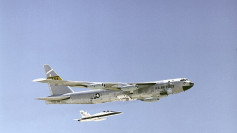North Korea has sharply condemned President Donald Trump's "Golden Dome" missile defense initiative, warning that the system could transform outer space into a "potential nuclear war field." The criticism, delivered through Pyongyang's state media, underscores mounting international alarm over the project's geopolitical and strategic implications.
The "Golden Dome," which Trump unveiled earlier this month, is a proposed $175 billion missile defense system that aims to integrate space-based sensors and interceptors to counter next-generation threats, including hypersonic, cruise, and ballistic missiles. The president said the system would be fully operational before the end of his current term in 2029.
"There's never been anything like this," Trump told reporters from the Oval Office, casting the system as the realization of a decades-long U.S. aspiration to shield its skies-tracing its lineage to Ronald Reagan's 1980s "Star Wars" initiative.
But Pyongyang called the U.S. plan "the height of self-righteousness [and] arrogance," and accused Washington of being "hell-bent... to militarise outer space." In a statement issued by North Korea's Foreign Ministry, officials warned the shield could provoke "a global nuclear and space arms race" and said it could "turn outer space into a potential nuclear war field."
China echoed the concerns. Speaking at a press briefing last week, Chinese Foreign Ministry spokeswoman Mao Ning said, "This highly offensive system violates the principle of peaceful use of outer space." Beijing accused Washington of adopting a "'US-first' policy" that jeopardizes global strategic stability.
Russian Foreign Ministry spokesperson Maria Zakharova also denounced the plan, saying it "directly undermines the basis of strategic stability."
The Congressional Budget Office recently projected the space-based portion of the Golden Dome could cost as much as $542 billion over 20 years-substantially higher than the administration's $175 billion headline figure. Trump has requested $25 billion in initial funding under a new defense spending bill making its way through Congress.
The U.S. currently deploys 44 Ground-Based Interceptors as part of its missile defense architecture, with 40 in Alaska and four in California. An additional 20 Next Generation Interceptors are expected to be added by 2028. These would be supplemented by the Navy's Aegis system. However, analysts say the current system remains insufficient for countering mass ICBM attacks from near-peer adversaries.
While the Pentagon argues that a more sophisticated, layered defense is critical amid rising threats, critics have questioned whether the Golden Dome can realistically deliver "genuinely impenetrable coverage of American airspace," given its scale and budget. "$175 billion could be enough to come up with a better version of existing capabilities, but not nearly enough to deliver genuinely impenetrable coverage," said Jacob Parakilas, a defense analyst with Rand.
U.S. allies have expressed interest in collaborating on the system. Trump said Canada has asked to participate, citing joint operations under the North American Aerospace Defense Command (NORAD).






